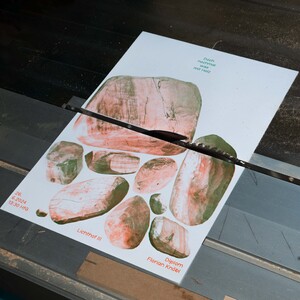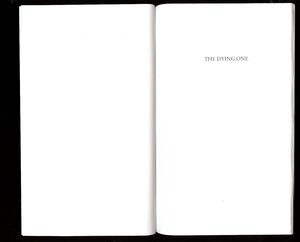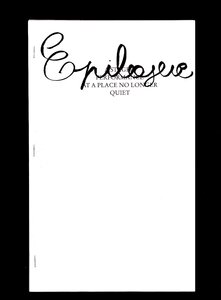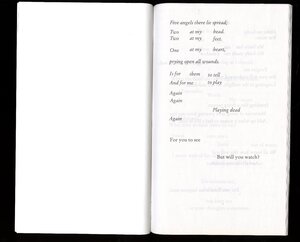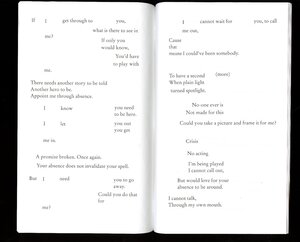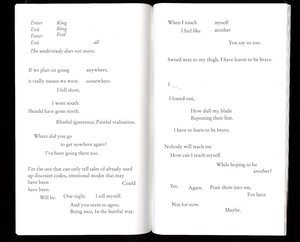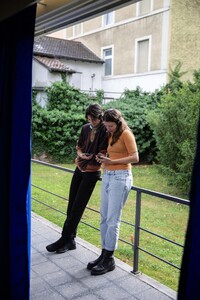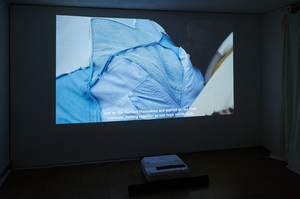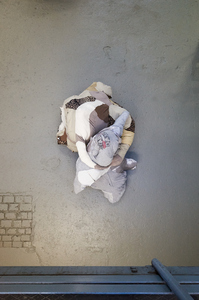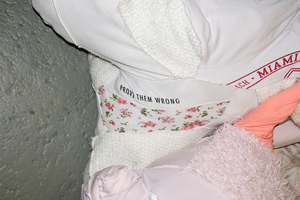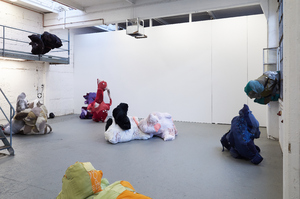Johanna Schäfer
| Name | Johanna Schäfer |
36 Inhalte
- Seite 1 von 3
Plakat
- Titel
- Plakat
- Autor/in
- Kategorie
- Schlagworte
- Material
- Ort: Institution
- Ort
- Lichthof 3
- Stadt
- Land
- Beteiligte Institution(en)
- Titel
- Plakat
- Urheberrechtshinweis
- © Florian Knöbl
- Rechtsschutz/Lizenz
- Freigabe Nutzung HfG
- Medienersteller/in
- Beziehung/Funktion
- Projektleiter/in
- Semester
- Studiengang
- Typ der Abschlussarbeit
- Importiert am
- 20.10.2024
- Übergeordnete Sets
- 1
Epilogue to a staged performance at a place no longer quiet_02
- Titel
- Epilogue to a staged performance at a place no longer quiet_02
- Untertitel
- Publikation zur Ausstellung "a staged performance at a place no longer quiet"
- Autor/in
- Beschreibung (en)
- The publication to my exhibition serves not as an explanation but as an extension of my shown work. Printed on old paper stock and staple bound the publication recalls the revealing of the structural elements of narration and immersion in my exhibition. The texts are extended fragments of the animated characters' monologues.
- Kategorie
- Typ des Projekts/Werks
- Mitwirkende
- Abmessungen
- 18,5 x 30cm
- Ort: Institution
- Stadt
- Land
- Titel
- Epilogue to a staged performance at a place no longer quiet_02
- Urheberrechtshinweis
- © Jonathan Blaschke
- Rechtsschutz/Lizenz
- Medienersteller/in
- Beziehung/Funktion
- Medien-Beschreibung
- Die Publikation zu meiner Ausstellung dient nicht als Erklärung, sondern als Erweiterung meiner gezeigten Arbeit. Gedruckt auf altem Papier und mit Klammerheftung erinnert die Publikation an die Offenlegung der Strukturelemente der Narration und Immersion in meiner Ausstellung. Die Texte sind erweiterte Fragmente der Monologe der animierten Figuren.
- Medien-Beschreibung (en)
- The publication to my exhibition serves not as an explanation but as an extension of my shown work. Printed on old paper stock and staple bound the publication recalls the revealing of the structural elements of narration and immersion in my exhibition. The texts are extended fragments of the animated characters' monologues.
- Semester
- Studiengang
- Typ der Abschlussarbeit
- Importiert am
- 16.02.2024
- Übergeordnete Sets
- 1
Epilogue to a staged performance at a place no longer quiet_01
- Titel
- Epilogue to a staged performance at a place no longer quiet_01
- Untertitel
- Publikation zur Ausstellung "a staged performance at a place no longer quiet"
- Autor/in
- Beschreibung (en)
- The publication to my exhibition serves not as an explanation but as an extension of my shown work. Printed on old paper stock and staple bound the publication recalls the revealing of the structural elements of narration and immersion in my exhibition. The texts are extended fragments of the animated characters' monologues.
- Kategorie
- Typ des Projekts/Werks
- Mitwirkende
- Abmessungen
- 18,5 x 30cm
- Ort: Institution
- Stadt
- Land
- Titel
- Epilogue to a staged performance at a place no longer quiet_01
- Urheberrechtshinweis
- © Jonathan Blaschke
- Rechtsschutz/Lizenz
- Medienersteller/in
- Beziehung/Funktion
- Medien-Beschreibung
- Die Publikation zu meiner Ausstellung dient nicht als Erklärung, sondern als Erweiterung meiner gezeigten Arbeit. Gedruckt auf altem Papier und mit Klammerheftung erinnert die Publikation an die Offenlegung der Strukturelemente der Narration und Immersion in meiner Ausstellung. Die Texte sind erweiterte Fragmente der Monologe der animierten Figuren.
- Medien-Beschreibung (en)
- The publication to my exhibition serves not as an explanation but as an extension of my shown work. Printed on old paper stock and staple bound the publication recalls the revealing of the structural elements of narration and immersion in my exhibition. The texts are extended fragments of the animated characters' monologues.
- Semester
- Studiengang
- Typ der Abschlussarbeit
- Importiert am
- 16.02.2024
- Übergeordnete Sets
- 1
Epilogue to a staged performance at a place no longer quiet_05
- Titel
- Epilogue to a staged performance at a place no longer quiet_05
- Untertitel
- Publikation zur Ausstellung "a staged performance at a place no longer quiet"
- Autor/in
- Beschreibung (en)
- The publication to my exhibition serves not as an explanation but as an extension of my shown work. Printed on old paper stock and staple bound the publication recalls the revealing of the structural elements of narration and immersion in my exhibition. The texts are extended fragments of the animated characters' monologues.
- Kategorie
- Typ des Projekts/Werks
- Mitwirkende
- Abmessungen
- 18,5 x 30cm
- Ort: Institution
- Stadt
- Land
- Titel
- Epilogue to a staged performance at a place no longer quiet_05
- Urheberrechtshinweis
- © Jonathan Blaschke
- Rechtsschutz/Lizenz
- Medienersteller/in
- Beziehung/Funktion
- Medien-Beschreibung
- Die Publikation zu meiner Ausstellung dient nicht als Erklärung, sondern als Erweiterung meiner gezeigten Arbeit. Gedruckt auf altem Papier und mit Klammerheftung erinnert die Publikation an die Offenlegung der Strukturelemente der Narration und Immersion in meiner Ausstellung. Die Texte sind erweiterte Fragmente der Monologe der animierten Figuren.
- Medien-Beschreibung (en)
- The publication to my exhibition serves not as an explanation but as an extension of my shown work. Printed on old paper stock and staple bound the publication recalls the revealing of the structural elements of narration and immersion in my exhibition. The texts are extended fragments of the animated characters' monologues.
- Semester
- Studiengang
- Typ der Abschlussarbeit
- Importiert am
- 16.02.2024
- Übergeordnete Sets
- 1
Epilogue to a staged performance at a place no longer quiet_06
- Titel
- Epilogue to a staged performance at a place no longer quiet_06
- Untertitel
- Publikation zur Ausstellung "a staged performance at a place no longer quiet"
- Autor/in
- Beschreibung (en)
- The publication to my exhibition serves not as an explanation but as an extension of my shown work. Printed on old paper stock and staple bound the publication recalls the revealing of the structural elements of narration and immersion in my exhibition. The texts are extended fragments of the animated characters' monologues.
- Kategorie
- Typ des Projekts/Werks
- Mitwirkende
- Abmessungen
- 18,5 x 30cm
- Ort: Institution
- Stadt
- Land
- Titel
- Epilogue to a staged performance at a place no longer quiet_06
- Urheberrechtshinweis
- © Jonathan Blaschke
- Rechtsschutz/Lizenz
- Medienersteller/in
- Beziehung/Funktion
- Medien-Beschreibung
- Die Publikation zu meiner Ausstellung dient nicht als Erklärung, sondern als Erweiterung meiner gezeigten Arbeit. Gedruckt auf altem Papier und mit Klammerheftung erinnert die Publikation an die Offenlegung der Strukturelemente der Narration und Immersion in meiner Ausstellung. Die Texte sind erweiterte Fragmente der Monologe der animierten Figuren.
- Medien-Beschreibung (en)
- The publication to my exhibition serves not as an explanation but as an extension of my shown work. Printed on old paper stock and staple bound the publication recalls the revealing of the structural elements of narration and immersion in my exhibition. The texts are extended fragments of the animated characters' monologues.
- Semester
- Studiengang
- Typ der Abschlussarbeit
- Importiert am
- 16.02.2024
- Übergeordnete Sets
- 1
Epilogue to a staged performance at a place no longer quiet_04
- Titel
- Epilogue to a staged performance at a place no longer quiet_04
- Untertitel
- Publikation zur Ausstellung "a staged performance at a place no longer quiet"
- Autor/in
- Beschreibung (en)
- The publication to my exhibition serves not as an explanation but as an extension of my shown work. Printed on old paper stock and staple bound the publication recalls the revealing of the structural elements of narration and immersion in my exhibition. The texts are extended fragments of the animated characters' monologues.
- Kategorie
- Typ des Projekts/Werks
- Mitwirkende
- Abmessungen
- 18,5 x 30cm
- Ort: Institution
- Stadt
- Land
- Titel
- Epilogue to a staged performance at a place no longer quiet_04
- Urheberrechtshinweis
- © Jonathan Blaschke
- Rechtsschutz/Lizenz
- Medienersteller/in
- Beziehung/Funktion
- Medien-Beschreibung
- Die Publikation zu meiner Ausstellung dient nicht als Erklärung, sondern als Erweiterung meiner gezeigten Arbeit. Gedruckt auf altem Papier und mit Klammerheftung erinnert die Publikation an die Offenlegung der Strukturelemente der Narration und Immersion in meiner Ausstellung. Die Texte sind erweiterte Fragmente der Monologe der animierten Figuren.
- Medien-Beschreibung (en)
- The publication to my exhibition serves not as an explanation but as an extension of my shown work. Printed on old paper stock and staple bound the publication recalls the revealing of the structural elements of narration and immersion in my exhibition. The texts are extended fragments of the animated characters' monologues.
- Semester
- Studiengang
- Typ der Abschlussarbeit
- Importiert am
- 16.02.2024
- Übergeordnete Sets
- 1
Epilogue to a staged performance at a place no longer quiet_03
- Titel
- Epilogue to a staged performance at a place no longer quiet_03
- Untertitel
- Publikation zur Ausstellung "a staged performance at a place no longer quiet"
- Autor/in
- Beschreibung (en)
- The publication to my exhibition serves not as an explanation but as an extension of my shown work. Printed on old paper stock and staple bound the publication recalls the revealing of the structural elements of narration and immersion in my exhibition. The texts are extended fragments of the animated characters' monologues.
- Kategorie
- Typ des Projekts/Werks
- Mitwirkende
- Abmessungen
- 18,5 x 30cm
- Ort: Institution
- Stadt
- Land
- Titel
- Epilogue to a staged performance at a place no longer quiet_03
- Urheberrechtshinweis
- © Jonathan Blaschke
- Rechtsschutz/Lizenz
- Medienersteller/in
- Beziehung/Funktion
- Medien-Beschreibung
- Die Publikation zu meiner Ausstellung dient nicht als Erklärung, sondern als Erweiterung meiner gezeigten Arbeit. Gedruckt auf altem Papier und mit Klammerheftung erinnert die Publikation an die Offenlegung der Strukturelemente der Narration und Immersion in meiner Ausstellung. Die Texte sind erweiterte Fragmente der Monologe der animierten Figuren.
- Medien-Beschreibung (en)
- The publication to my exhibition serves not as an explanation but as an extension of my shown work. Printed on old paper stock and staple bound the publication recalls the revealing of the structural elements of narration and immersion in my exhibition. The texts are extended fragments of the animated characters' monologues.
- Semester
- Studiengang
- Typ der Abschlussarbeit
- Importiert am
- 16.02.2024
- Übergeordnete Sets
- 1
Disparate Precedents of Display
- Titel
- Disparate Precedents of Display
- Titel (en)
- Disparate Precedents of Display
- Untertitel
- A Footnote
- Untertitel des Projekts/Werks (en)
- A Footnote
- Autor/in
- Beschreibung (de)
- Das Projekt befasst sich mit den politischen Dimensionen der Ausstellungsgestaltung und führt durch zwei vom Architekten Egon Eiermann gestaltete Ausstellungen. Es erforscht die Verschränkung von Design und Politik, Nationalsozialismus und Formen der Repräsentation.
"Disparate Precedents of Display" untersucht die Art und Weise, wie der Raum auf die Besucher wirkt, und stellt Ausstellungsdesign als eine genuin politische Praxis dar, die auf der Vergangenheit aufbaut und von ihr erbt - von vergangenen Ausstellungen, einflussreichen Ausstellungsgestalter*innen und Konventionen der Präsentation, die in unterschiedlichen politischen Systemen wurzeln.
Zwei Ausstellungen, die vom deutschen Staat in Auftrag gegeben wurden, dienen als Fallstudien. "Gebt mir vier Jahre Zeit" war eine nationalsozialistische Propagandaschau, die 1937 in Berlin stattfand. Sie feierte die Umgestaltung aller Bereiche der Gesellschaft unter der nationalsozialistischen Herrschaft seit der Umsetzung von Adolf Hitlers Vierjahresplan. Einundzwanzig Jahre später beauftragte die Bundesrepublik Deutschland denselben Architekten mit der Gestaltung des deutschen Pavillons auf der Expo '58 in Brüssel. Auf der Weltausstellung hatte der junge Nachfolgestaat zum ersten Mal die Gelegenheit, die kulturellen, wirtschaftlichen und politischen Parameter des nunmehr demokratischen Deutschlands auf internationaler Ebene zu präsentieren. Beide Ausstellungen lassen sich als Repräsentationen staatlicher Macht und politischer Narrative beschreiben - die eine im Namen des Krieges, die andere im Namen der Humanität. Maßgeblich beteiligt an beiden Ausstellungen war Egon Eiermann als Ausstellungsarchitekt.
Performance: Anna K. Seidel
Outside Eye: Caroline Kapp, Manon Haase
Graphikdesign: Mona Mayer
Single line font EE_7475: Barbara Acevedo Strange, Moritz Appich
Coding: Frank Bublitz
Stimme: Liv Rahel Schwenk
Aufzeichnung: Florian Wulff
Video Dokumentation: Mustafa Emin Büyükcoşkun
Photographien: Lizzy Ellbrück
Editorial support: Joyce Moore
Copyediting: George MacBeth
Special Thanks to
Céline Condorelli, Hanne König, Sami Khatib, Lioudmila Voropai,
Julian Warner, Thomas Rustemeyer, Constanze Fischbeck,
Susanne Kriemann, Hans D. Christ und Iris Dressler, Judith Milz,
Christian Becker (Stadtarchiv Oranienburg), Mechthild Ebert (saai),
Janina Capelle, Lydia Kähny, Daniel Lythgoe, Tjark Schönfeld,
Alexander Knoppik, Lena Breitmoser, Sören Göbel, Jule Köpke, Arthur Schuman,
Jana Barthel and Danny Klein.
Gefördert von
Fonds Darstellende Künste (Rechercheförderung)
Rosa Luxemburg Stiftung Baden Württemberg
- Das Projekt befasst sich mit den politischen Dimensionen der Ausstellungsgestaltung und führt durch zwei vom Architekten Egon Eiermann gestaltete Ausstellungen. Es erforscht die Verschränkung von Design und Politik, Nationalsozialismus und Formen der Repräsentation.
- Beschreibung (en)
- The project addresses the political dimensions of exhibition design, leading through
two exhibitions designed by architect Egon Eiermann. It explores the entanglement of
design and politics, National Socialism and forms of representation.
"Disparate Precedents of Display" looks at the way space affects visitors, exposing exhibition design as a genuinely political practice, building on and inheriting from the past – from past exhibitions, influential exhibition designers and conventions of display rooted in disparate political systems.
Two exhibitions, commissioned by the German state, serve as case studies. “Gebt mir vier Jahre Zeit” was a National Socialist propaganda show staged in Berlin in 1937. It celebrated the transformation of all sectors of society under National Socialist rule since the implementation of Adolf Hitlers 4-year-plan. Twenty-one years later, the Federal Republic of Germany commissioned the same architect to design the German Pavilion at the Expo ‘58 in Brussels. At the World‘s Fair the young successor state had its first opportunity to present the cultural, economic and political parameters of a now democratic Germany on an international scale. Both shows can be described as representations of state power and political narratives – one in the name of war and one in the name of humanity. Significant contributor to both exhibitions was Egon Eiermann in his role as exhibition architect.
Performance: Anna K. Seidel
Outside Eye: Caroline Kapp, Manon Haase
Graphic Design: Mona Mayer
Single line font EE_7475: Barbara Acevedo Strange, Moritz Appich
Coding: Frank Bublitz
Voice: Liv Rahel Schwenk
Recording: Florian Wulff
Video documentation: Mustafa Emin Büyükcoşkun
Photography: Lizzy Ellbrück
Editorial support: Joyce Moore
Copyediting: George MacBeth
Special Thanks to
Céline Condorelli, Hanne König, Sami Khatib, Lioudmila Voropai,
Julian Warner, Thomas Rustemeyer, Constanze Fischbeck,
Susanne Kriemann, Hans D. Christ und Iris Dressler, Judith Milz,
Christian Becker (Stadtarchiv Oranienburg), Mechthild Ebert (saai),
Janina Capelle, Lydia Kähny, Daniel Lythgoe, Tjark Schönfeld,
Alexander Knoppik, Lena Breitmoser, Sören Göbel, Jule Köpke, Arthur Schuman,
Jana Barthel and Danny Klein.
Funded by
Fonds Darstellende Künste (Rechercheförderung)
Rosa Luxemburg Stiftung Baden Württemberg
- The project addresses the political dimensions of exhibition design, leading through
- Typ des Projekts/Werks
- Schlagworte
- Datierung
- 28.07.2023
- Mitwirkende
- Dank an
- Sprache
- Dauer
- Performance: ca. 30 Minuten
- Ort
- Brauerstraße 2
- Stadt
- Land
- Titel
- Disparate Precedents of Display
- Urheberrechtshinweis
- Teresa Häußler, Lizzy Ellbrück
- Rechtsschutz/Lizenz
- Freigabe Nutzung HfG
- Medienersteller/in
- Beziehung/Funktion
- Medien-Beschreibung
- Publikum mit Kopfhörern
- Medien-Beschreibung (en)
- audience listening to audio piece via headphones
- Abgebildete Personen
- Projektleiter/in
- Semester
- Studiengang
- Typ der Abschlussarbeit
- Importiert am
- 28.09.2023
- Übergeordnete Sets
- 1
Installationsansicht / Videoraum
- Titel
- Installationsansicht / Videoraum
- Untertitel
- Elastic Kin
- Autor/in
- Beschreibung (de)
- Die Rauminstallation “Elastic Kin” zeigt eine Gruppe von Textilobjekten - Gefüge -, die aus weggeworfenen Kleidungsstücken bestehen. Sie existieren sowohl als Individuen als auch als Gruppe. Die Kleidungsstücke, die in den Straße von K. gefunden wurden und von Anderen in anderen Kontext hergestellt worden sind, kehren ihren ursprünglichen Zweck um, indem sie zu eigenen Körpern werden, die unabhängig von menschlichen Körpern sind. Jede Oberfläche ist wie eine geheime Landkarte, die Spuren anonymer Hände enthält, die an den Textilien gearbeitet haben.
Der Sound der Installation ist ein Echo - fast verschwundener, kollektiver Erinnerungen an vergangene Momente und Orte.
“Elastic Kin” versucht, eine weit verbreitete Verwandtschaft darzustellen, die durch unsichtbare, lose und elastische Fäden imaginiert wird, die ein internationales System von Lieferketten, Arbeiter*Innen und Konsument*Innen, Trendprognosen und unvorhersehbarem Zeitgeist, Massenproduktion und meditativer Handarbeit abbilden. Welche Spuren dieser Kontexte enthalten die Kleidungsstücke?
Das Video zeigt eine performative Intervention im öffentlichen Raum. Es zeigt die Gefüge, die eine neue Existenz außerhalb ihrer Produktions- und Vermarktungskontexte führen: Sie kehren in ein Einkaufszentrum zurück, animiert von den Menschen, die sie einst bekleideten.
- Die Rauminstallation “Elastic Kin” zeigt eine Gruppe von Textilobjekten - Gefüge -, die aus weggeworfenen Kleidungsstücken bestehen. Sie existieren sowohl als Individuen als auch als Gruppe. Die Kleidungsstücke, die in den Straße von K. gefunden wurden und von Anderen in anderen Kontext hergestellt worden sind, kehren ihren ursprünglichen Zweck um, indem sie zu eigenen Körpern werden, die unabhängig von menschlichen Körpern sind. Jede Oberfläche ist wie eine geheime Landkarte, die Spuren anonymer Hände enthält, die an den Textilien gearbeitet haben.
- Beschreibung (en)
- The spatial installation “Elastic Kin” shows a group of textile objects – Gefüge – that were assembled from discarded and abandoned garments. They exist as individuals as well as a kin. Assembled from used garments, found in the streets of K., produced by others in other contexts, they invert their original purpose by becoming bodies of their own, no longer dependent on being activated by a human body. The surface of every Gefüge is like a secret map, containing traces of anonymous hands working on them.
The sound in the installation is an echo of almost vanished collective memories of past moments and places. “Elastic Kin” attempts to depict a widespread kinship, that is imagined through invisible, loose and elastic threads mapping an international system of supply chains, workers and consumers, trend forecast and unpredictable zeitgeist, mass production and meditative handcraft. Which traces of these contexts do the garments contain?
The video shows a performative intervention in pub- lic space. It shows the Gefüge leading a new existence outside their production and marketing contexts: They return to the shopping mall, animated by the people, they once used to dress.
- The spatial installation “Elastic Kin” shows a group of textile objects – Gefüge – that were assembled from discarded and abandoned garments. They exist as individuals as well as a kin. Assembled from used garments, found in the streets of K., produced by others in other contexts, they invert their original purpose by becoming bodies of their own, no longer dependent on being activated by a human body. The surface of every Gefüge is like a secret map, containing traces of anonymous hands working on them.
- Typ des Projekts/Werks
- Schlagworte
- Datierung
- 18.10.2023
- Mitwirkende
- Dank an
- Sprache
- Untertitel (Film)
- Material
- Ort: Institution
- Stadt
- Land
- Titel
- Installationsansicht / Videoraum
- Urheberrechtshinweis
- Corinne Riepert
- Rechtsschutz/Lizenz
- Freigabe Nutzung HfG
- Medienersteller/in
- Beziehung/Funktion
- Projektleiter/in
- Semester
- Studiengang
- Typ der Abschlussarbeit
- Importiert am
- 02.11.2023
- Übergeordnete Sets
- 1
Installationsansicht
- Titel
- Installationsansicht
- Untertitel
- Elastic Kin
- Autor/in
- Beschreibung (de)
- Die Rauminstallation “Elastic Kin” zeigt eine Gruppe von Textilobjekten - Gefüge -, die aus weggeworfenen Kleidungsstücken bestehen. Sie existieren sowohl als Individuen als auch als Gruppe. Die Kleidungsstücke, die in den Straße von K. gefunden wurden und von Anderen in anderen Kontext hergestellt worden sind, kehren ihren ursprünglichen Zweck um, indem sie zu eigenen Körpern werden, die unabhängig von menschlichen Körpern sind. Jede Oberfläche ist wie eine geheime Landkarte, die Spuren anonymer Hände enthält, die an den Textilien gearbeitet haben.
Der Sound der Installation ist ein Echo - fast verschwundener, kollektiver Erinnerungen an vergangene Momente und Orte.
“Elastic Kin” versucht, eine weit verbreitete Verwandtschaft darzustellen, die durch unsichtbare, lose und elastische Fäden imaginiert wird, die ein internationales System von Lieferketten, Arbeiter*Innen und Konsument*Innen, Trendprognosen und unvorhersehbarem Zeitgeist, Massenproduktion und meditativer Handarbeit abbilden. Welche Spuren dieser Kontexte enthalten die Kleidungsstücke?
Das Video zeigt eine performative Intervention im öffentlichen Raum. Es zeigt die Gefüge, die eine neue Existenz außerhalb ihrer Produktions- und Vermarktungskontexte führen: Sie kehren in ein Einkaufszentrum zurück, animiert von den Menschen, die sie einst bekleideten.
- Die Rauminstallation “Elastic Kin” zeigt eine Gruppe von Textilobjekten - Gefüge -, die aus weggeworfenen Kleidungsstücken bestehen. Sie existieren sowohl als Individuen als auch als Gruppe. Die Kleidungsstücke, die in den Straße von K. gefunden wurden und von Anderen in anderen Kontext hergestellt worden sind, kehren ihren ursprünglichen Zweck um, indem sie zu eigenen Körpern werden, die unabhängig von menschlichen Körpern sind. Jede Oberfläche ist wie eine geheime Landkarte, die Spuren anonymer Hände enthält, die an den Textilien gearbeitet haben.
- Beschreibung (en)
- The spatial installation “Elastic Kin” shows a group of textile objects – Gefüge – that were assembled from discarded and abandoned garments. They exist as individuals as well as a kin. Assembled from used garments, found in the streets of K., produced by others in other contexts, they invert their original purpose by becoming bodies of their own, no longer dependent on being activated by a human body. The surface of every Gefüge is like a secret map, containing traces of anonymous hands working on them.
The sound in the installation is an echo of almost vanished collective memories of past moments and places. “Elastic Kin” attempts to depict a widespread kinship, that is imagined through invisible, loose and elastic threads mapping an international system of supply chains, workers and consumers, trend forecast and unpredictable zeitgeist, mass production and meditative handcraft. Which traces of these contexts do the garments contain?
The video shows a performative intervention in pub- lic space. It shows the Gefüge leading a new existence outside their production and marketing contexts: They return to the shopping mall, animated by the people, they once used to dress.
- The spatial installation “Elastic Kin” shows a group of textile objects – Gefüge – that were assembled from discarded and abandoned garments. They exist as individuals as well as a kin. Assembled from used garments, found in the streets of K., produced by others in other contexts, they invert their original purpose by becoming bodies of their own, no longer dependent on being activated by a human body. The surface of every Gefüge is like a secret map, containing traces of anonymous hands working on them.
- Typ des Projekts/Werks
- Schlagworte
- Datierung
- 18.10.2023
- Mitwirkende
- Dank an
- Sprache
- Untertitel (Film)
- Material
- Ort: Institution
- Stadt
- Land
- Titel
- Installationsansicht
- Urheberrechtshinweis
- Corinne Riepert
- Rechtsschutz/Lizenz
- Freigabe Nutzung HfG
- Medienersteller/in
- Beziehung/Funktion
- Projektleiter/in
- Semester
- Studiengang
- Typ der Abschlussarbeit
- Importiert am
- 02.11.2023
- Übergeordnete Sets
- 1
Detail
- Titel
- Detail
- Untertitel
- Elastic Kin
- Autor/in
- Beschreibung (de)
- Die Rauminstallation “Elastic Kin” zeigt eine Gruppe von Textilobjekten - Gefüge -, die aus weggeworfenen Kleidungsstücken bestehen. Sie existieren sowohl als Individuen als auch als Gruppe. Die Kleidungsstücke, die in den Straße von K. gefunden wurden und von Anderen in anderen Kontext hergestellt worden sind, kehren ihren ursprünglichen Zweck um, indem sie zu eigenen Körpern werden, die unabhängig von menschlichen Körpern sind. Jede Oberfläche ist wie eine geheime Landkarte, die Spuren anonymer Hände enthält, die an den Textilien gearbeitet haben.
Der Sound der Installation ist ein Echo - fast verschwundener, kollektiver Erinnerungen an vergangene Momente und Orte.
“Elastic Kin” versucht, eine weit verbreitete Verwandtschaft darzustellen, die durch unsichtbare, lose und elastische Fäden imaginiert wird, die ein internationales System von Lieferketten, Arbeiter*Innen und Konsument*Innen, Trendprognosen und unvorhersehbarem Zeitgeist, Massenproduktion und meditativer Handarbeit abbilden. Welche Spuren dieser Kontexte enthalten die Kleidungsstücke?
Das Video zeigt eine performative Intervention im öffentlichen Raum. Es zeigt die Gefüge, die eine neue Existenz außerhalb ihrer Produktions- und Vermarktungskontexte führen: Sie kehren in ein Einkaufszentrum zurück, animiert von den Menschen, die sie einst bekleideten.
- Die Rauminstallation “Elastic Kin” zeigt eine Gruppe von Textilobjekten - Gefüge -, die aus weggeworfenen Kleidungsstücken bestehen. Sie existieren sowohl als Individuen als auch als Gruppe. Die Kleidungsstücke, die in den Straße von K. gefunden wurden und von Anderen in anderen Kontext hergestellt worden sind, kehren ihren ursprünglichen Zweck um, indem sie zu eigenen Körpern werden, die unabhängig von menschlichen Körpern sind. Jede Oberfläche ist wie eine geheime Landkarte, die Spuren anonymer Hände enthält, die an den Textilien gearbeitet haben.
- Beschreibung (en)
- The spatial installation “Elastic Kin” shows a group of textile objects – Gefüge – that were assembled from discarded and abandoned garments. They exist as individuals as well as a kin. Assembled from used garments, found in the streets of K., produced by others in other contexts, they invert their original purpose by becoming bodies of their own, no longer dependent on being activated by a human body. The surface of every Gefüge is like a secret map, containing traces of anonymous hands working on them.
The sound in the installation is an echo of almost vanished collective memories of past moments and places. “Elastic Kin” attempts to depict a widespread kinship, that is imagined through invisible, loose and elastic threads mapping an international system of supply chains, workers and consumers, trend forecast and unpredictable zeitgeist, mass production and meditative handcraft. Which traces of these contexts do the garments contain?
The video shows a performative intervention in pub- lic space. It shows the Gefüge leading a new existence outside their production and marketing contexts: They return to the shopping mall, animated by the people, they once used to dress.
- The spatial installation “Elastic Kin” shows a group of textile objects – Gefüge – that were assembled from discarded and abandoned garments. They exist as individuals as well as a kin. Assembled from used garments, found in the streets of K., produced by others in other contexts, they invert their original purpose by becoming bodies of their own, no longer dependent on being activated by a human body. The surface of every Gefüge is like a secret map, containing traces of anonymous hands working on them.
- Typ des Projekts/Werks
- Schlagworte
- Datierung
- 18.10.2023
- Mitwirkende
- Dank an
- Sprache
- Untertitel (Film)
- Material
- Ort: Institution
- Stadt
- Land
- Titel
- Detail
- Urheberrechtshinweis
- Corinne Riepert
- Rechtsschutz/Lizenz
- Freigabe Nutzung HfG
- Medienersteller/in
- Beziehung/Funktion
- Projektleiter/in
- Semester
- Studiengang
- Typ der Abschlussarbeit
- Importiert am
- 02.11.2023
- Übergeordnete Sets
- 1
Installationsansicht
- Titel
- Installationsansicht
- Titel (en)
- Elastic Kin
- Untertitel
- Foto Dokumentation
- Autor/in
- Beschreibung (de)
- Die Rauminstallation “Elastic Kin” zeigt eine Gruppe von Textilobjekten - Gefüge -, die aus weggeworfenen Kleidungsstücken bestehen. Sie existieren sowohl als Individuen als auch als Gruppe. Die Kleidungsstücke, die in den Straße von K. gefunden wurden und von Anderen in anderen Kontext hergestellt worden sind, kehren ihren ursprünglichen Zweck um, indem sie zu eigenen Körpern werden, die unabhängig von menschlichen Körpern sind. Jede Oberfläche ist wie eine geheime Landkarte, die Spuren anonymer Hände enthält, die an den Textilien gearbeitet haben.
Der Sound der Installation ist ein Echo - fast verschwundener, kollektiver Erinnerungen an vergangene Momente und Orte.
“Elastic Kin” versucht, eine weit verbreitete Verwandtschaft darzustellen, die durch unsichtbare, lose und elastische Fäden imaginiert wird, die ein internationales System von Lieferketten, Arbeiter*Innen und Konsument*Innen, Trendprognosen und unvorhersehbarem Zeitgeist, Massenproduktion und meditativer Handarbeit abbilden. Welche Spuren dieser Kontexte enthalten die Kleidungsstücke?
Das Video zeigt eine performative Intervention im öffentlichen Raum. Es zeigt die Gefüge, die eine neue Existenz außerhalb ihrer Produktions- und Vermarktungskontexte führen: Sie kehren in ein Einkaufszentrum zurück, animiert von den Menschen, die sie einst bekleideten.
- Die Rauminstallation “Elastic Kin” zeigt eine Gruppe von Textilobjekten - Gefüge -, die aus weggeworfenen Kleidungsstücken bestehen. Sie existieren sowohl als Individuen als auch als Gruppe. Die Kleidungsstücke, die in den Straße von K. gefunden wurden und von Anderen in anderen Kontext hergestellt worden sind, kehren ihren ursprünglichen Zweck um, indem sie zu eigenen Körpern werden, die unabhängig von menschlichen Körpern sind. Jede Oberfläche ist wie eine geheime Landkarte, die Spuren anonymer Hände enthält, die an den Textilien gearbeitet haben.
- Beschreibung (en)
- The spatial installation “Elastic Kin” shows a group of textile objects – Gefüge – that were assembled from discarded and abandoned garments. They exist as individuals as well as a kin. Assembled from used garments, found in the streets of K., produced by others in other contexts, they invert their original purpose by becoming bodies of their own, no longer dependent on being activated by a human body. The surface of every Gefüge is like a secret map, containing traces of anonymous hands working on them.
The sound in the installation is an echo of almost vanished collective memories of past moments and places. “Elastic Kin” attempts to depict a widespread kinship, that is imagined through invisible, loose and elastic threads mapping an international system of supply chains, workers and consumers, trend forecast and unpredictable zeitgeist, mass production and meditative handcraft. Which traces of these contexts do the garments contain?
The video shows a performative intervention in pub- lic space. It shows the Gefüge leading a new existence outside their production and marketing contexts: They return to the shopping mall, animated by the people, they once used to dress.
- The spatial installation “Elastic Kin” shows a group of textile objects – Gefüge – that were assembled from discarded and abandoned garments. They exist as individuals as well as a kin. Assembled from used garments, found in the streets of K., produced by others in other contexts, they invert their original purpose by becoming bodies of their own, no longer dependent on being activated by a human body. The surface of every Gefüge is like a secret map, containing traces of anonymous hands working on them.
- Typ des Projekts/Werks
- Schlagworte
- Datierung
- 18.10.2023
- Mitwirkende
- Dank an
- Sprache
- Untertitel (Film)
- Material
- Ort: Institution
- Stadt
- Land
- Titel
- Installationsansicht
- Urheberrechtshinweis
- Corinne Riepert
- Rechtsschutz/Lizenz
- Freigabe Nutzung HfG
- Medienersteller/in
- Beziehung/Funktion
- Projektleiter/in
- Semester
- Studiengang
- Typ der Abschlussarbeit
- Importiert am
- 06.11.2023
- Übergeordnete Sets
- 1
